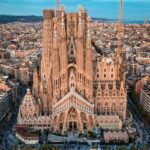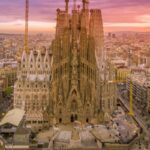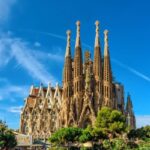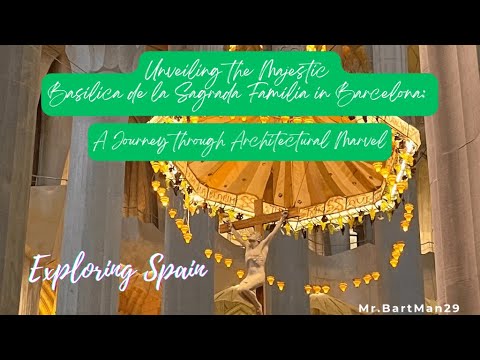
Barcelona, a city brimming with artistic heritage and architectural wonders, offers visitors a unique blend of history and modernity. Among its most iconic landmarks is the Sagrada Familia, a basilica that captivates the imagination with its intricate designs and towering spires.
In this journey of discovery, we delve into the heart of this magnificent structure. Join us in **Exploring Barcelona: Unveiling the Majestic Sagrada Familia**, where we uncover the stories, artistry, and vision behind one of the most remarkable masterpieces of the modern era.
Exploring the Architectural Wonders of Sagrada Familia
The Sagrada Familia is not just a basilica; it is a testament to innovative architecture and visionary design. Antoni Gaudí's work combines Gothic and Art Nouveau styles, resulting in a structure that is both monumental and organic. Each façade tells a story, inviting visitors to explore its intricate sculptures and symbolic elements, reflecting the life of Jesus and the natural world.
One of the architectural wonders of the Sagrada Familia is its unique structural engineering. Utilizing hyperboloid shapes and catenary arches, Gaudí aimed to create a building that harmonizes with nature. Key features include:
- Towers: Rising to heights of up to 172.5 meters, representing the celestial hierarchy.
- Interior Columns: Designed to resemble trees, providing support while creating a forest-like atmosphere.
- Stained Glass Windows: Filtering light into vibrant colors that change throughout the day.
As you wander through the basilica, the play of light and shadow within the interior space creates a mesmerizing effect. Gaudí's use of natural forms inspires awe and evokes a sense of tranquility, making each visit a unique experience. This innovative approach to design not only enhances the aesthetic but also embodies a connection to the divine.
The ongoing construction of the Sagrada Familia speaks to its enduring legacy. With completion projected for 2026, the basilica continues to evolve, reflecting modern advancements while remaining true to Gaudí's original vision. This fusion of tradition and innovation underscores the importance of preserving architectural heritage while embracing the future.
The History and Significance of the Sagrada Familia
The Sagrada Familia's history dates back to 1882, when construction began under the direction of architect Francisco de Paula del Villar. However, it was the visionary Antoni Gaudí who took over in 1883, infusing the project with his unique artistic vision. His innovative approach transformed the basilica into a symbol of Barcelona, melding religious significance with unparalleled architectural creativity.
Throughout the years, the basilica has faced numerous challenges, including funding shortages and the Spanish Civil War, which halted construction. Despite these obstacles, the dedication to completing Gaudí's dream has persisted, and today, the Sagrada Familia stands as a UNESCO World Heritage site, recognized for its cultural and historical importance. This extraordinary structure embodies the spirit of Barcelona, drawing millions of visitors annually.
Key milestones in the history of the Sagrada Familia include:
- 1882: Construction begins with a different architect.
- 1883: Antoni Gaudí takes over the project.
- 1926: Gaudí's death; construction continues based on his plans.
- 2026: Expected completion, marking the centenary of Gaudí's death.
The significance of the Sagrada Familia extends beyond its architectural marvel. It represents the fusion of faith, art, and community, embodying the aspirations of the people of Barcelona. As it nears completion, the basilica not only preserves Gaudí's legacy but also inspires future generations to appreciate the beauty of sacred architecture and the importance of cultural heritage.
Top Tips for Visiting Sagrada Familia in Barcelona
To fully enjoy your visit to the Sagrada Familia, consider purchasing your tickets online in advance. This can help you avoid long queues, allowing you to maximize your time exploring the basilica's stunning architecture. Additionally, choose a timed entry slot that works well with your schedule to ensure a smooth experience.
Another great tip is to take a guided tour. Engaging with a knowledgeable guide can provide deeper insights into the history and symbolism behind Gaudí's magnificent work. Here are some benefits of a guided tour:
- In-depth knowledge: Guides share stories and facts that might be missed otherwise.
- Skip-the-line access: Some tours offer priority entry, reducing wait times.
- Unique perspectives: Learn about lesser-known details and architectural features.
For the best experience, consider visiting during off-peak hours, such as early morning or late afternoon. This not only allows for fewer crowds but also provides the opportunity to enjoy the breathtaking play of light inside the basilica as the sun sets. Remember to allocate enough time to explore the exterior as well as the interior, as each façade has its own unique story.
Lastly, don't forget to check the schedule for any special events or services taking place during your visit. The Sagrada Familia often hosts concerts and religious ceremonies, providing a unique opportunity to witness the basilica's beauty in a different context. Here’s a quick checklist for your visit:
- Purchase tickets online.
- Consider a guided tour for deeper insights.
- Visit during off-peak hours for a quieter experience.
- Check for events or services happening during your visit.
Unraveling the Symbolism Behind Sagrada Familia's Design
The design of the Sagrada Familia is a rich tapestry of symbolism that reflects both Gaudí's spiritual beliefs and his deep connection to nature. Each element has meaning, with the basilica serving as a visual narrative of the Christian faith. For example, the three grand façades—Nativity, Passion, and Glory—represent the life of Christ, communicating profound theological themes through architecture. This approach transforms the basilica into a living scripture, inviting contemplation and reflection.
Gaudí ingeniously incorporated natural forms into the Sagrada Familia, using geometric shapes and organic motifs that mimic the world around us. The columns, resembling tree trunks, not only provide structural support but also symbolize the connection between heaven and earth. The basilica’s intricate façades showcase elements like fruits, flowers, and animals, each carefully chosen to reflect the harmony of creation. This organic design philosophy is fundamental in demonstrating Gaudí's belief that architecture should coexist with nature.
Another significant aspect of the Sagrada Familia's design is its emphasis on light. Gaudí envisioned the manipulation of light as a means to evoke emotional responses within the space. The stained glass windows are strategically placed to filter sunlight in various colors, creating an ethereal atmosphere that shifts throughout the day. This play of light not only enhances the aesthetic experience but also serves as a metaphor for divine illumination, reinforcing the spiritual essence of the basilica.
In its entirety, the Sagrada Familia stands as a profound emblem of faith and creativity. As visitors explore its majestic spaces, they encounter a harmonious blend of art and spirituality, making each visit a transformative experience. The ongoing construction reflects a commitment to preserving Gaudí's vision while embracing contemporary techniques, ensuring that this architectural marvel continues to inspire generations to come.
Experience the Best Views of Sagrada Familia
To truly experience the best views of the Sagrada Familia, head to the rooftop of the nearby Casa de les Punxes. This vantage point provides a stunning landscape of the basilica against the backdrop of Barcelona's skyline. As you gaze upon the intricate spires and colorful mosaics from above, you'll appreciate Gaudí's visionary architecture in a new light. The combination of rooftops and the iconic structure creates a captivating panorama that should not be missed.
Another excellent location for a breathtaking view is the Torre Bellesguard, designed by Gaudí himself. This lesser-known gem allows visitors to capture the basilica from an angle that highlights its unique silhouette. The surrounding gardens and tranquil atmosphere make it a perfect spot for photography or a peaceful moment of reflection. Don't forget to bring your camera to immortalize this picturesque scene.
For those who prefer a more immersive experience, consider booking a ticket to ascend one of the Sagrada Familia’s towers. From the top, you are rewarded with a panoramic view of the city and surrounding areas, where the architectural brilliance of Gaudí unfolds before your eyes. The ascent provides an opportunity to observe the intricate details of the basilica up close, making it a favorite among visitors seeking a unique perspective.
Lastly, the Plaza de la Sagrada Familia offers a spacious area to soak in the stunning beauty of the basilica. Here, you can relax on a bench while enjoying the different angles of this magnificent structure. As the sun sets, the changing colors of the façade create a magical atmosphere, transforming your visit into an unforgettable experience. Remember to take your time and truly absorb the splendor of this architectural marvel.
A Journey Through the Life of Antoni Gaudí and Sagrada Familia
Antoni Gaudí, born in 1852, is celebrated as one of the most innovative architects of the 20th century, and his masterpiece, the Sagrada Familia, reflects his extraordinary vision. His journey as an architect was deeply influenced by his love for nature, spirituality, and the unique culture of Catalonia. Gaudí's unconventional techniques and use of vibrant colors created a style that was both unique and timeless, setting a new standard in architectural design.
Gaudí's dedication to the Sagrada Familia began in 1883, and he devoted the majority of his life to this ambitious project. His background in art and architecture led him to incorporate a variety of elements into the design, such as:
- Natural Forms: Inspired by the shapes and structures found in nature.
- Religious Symbolism: Each detail is imbued with theological meaning.
- Innovative Materials: Use of ceramics and stained glass to enhance visual appeal.
Throughout the years, Gaudí faced numerous challenges, including limited funding and the impact of the Spanish Civil War. Nevertheless, his unwavering commitment to the project ensured that it would evolve continually. Today, the Sagrada Familia stands as a symbol of resilience, representing not only Gaudí's genius but also the collective spirit and aspirations of the people of Barcelona.
As we continue to witness the ongoing construction of the Sagrada Familia, we honor Gaudí's legacy by appreciating how his visionary ideals have persisted through the decades. With an expected completion in 2026, the basilica will not only pay homage to Gaudí's intricate designs but also stand as a testament to the fusion of history and modernity in architectural practice.
 Discover the Breathtaking Aerial View of Barcelona's Sagrada Familia
Discover the Breathtaking Aerial View of Barcelona's Sagrada Familia Unparalleled Views: Barcelona Hotels with Sagrada Familia View
Unparalleled Views: Barcelona Hotels with Sagrada Familia View Discover the Spectacular Sagrada Familia with Viator Barcelona
Discover the Spectacular Sagrada Familia with Viator BarcelonaIf you want to know other articles similar to Exploring Barcelona: Unveiling the Majestic Sagrada Familia you can visit the category WHERE YOU CAN GO.
Leave a Reply










Read more!